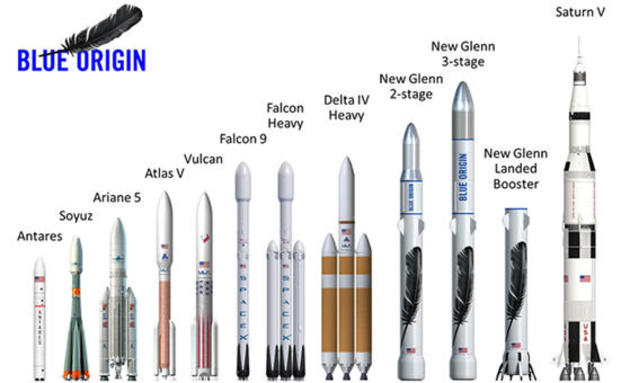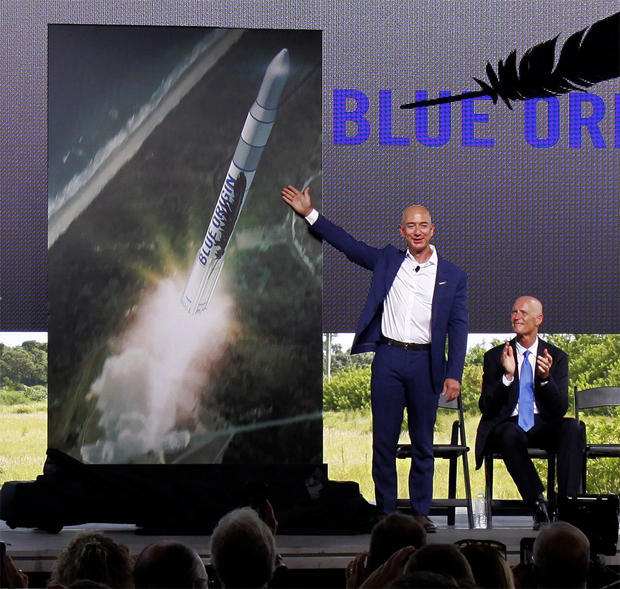Jeff Bezos unveils details of new Blue Origin rocket
Jeff Bezos, whose company Blue Origin is quietly developing a wide range of commercial launch vehicles, unveiled details of a new heavy-lift rocket Monday, a towering booster named after astronaut John Glenn that the Amazon founder says will be able to deliver crews and cargoes to low-Earth orbit and beyond.
A two-stage version of the New Glenn booster will stand 270 feet tall, have a diameter of 23 feet and will generate 3.85 million pounds of thrust at liftoff using seven company-developed BE-4 engines burning liquefied natural gas and liquid oxygen. The second stage will be powered by a single BE-4 optimized for use in vacuum.
A three-stage variant will stand 313 feet tall, using a single BE-4 for the second stage and a single hydrogen-powered BE-3 engine in its third stage. The BE-3 already is in use with Blue Origin’s sub-orbital New Shepard rocket, designed to carry tourists, researchers and small payloads to the edge of space and back from a launch site in Texas.
The BE-4 at the heart of the New Glenn rocket is the leading candidate for powering the first stage of United Launch Alliance’s new Vulcan booster, which ULA is developing to replace the company’s workhorse Atlas and Delta rockets. Tory Bruno, ULA’s CEO, told CBS News last week that initial test firings of the BE-4 are expected before or just after the end of the year.
Like the New Shepard rocket, the New Glenn will feature a reusable first stage that will fly itself to touchdown on an off-shore barge or on a landing pad near the launch site. SpaceX already has successfully demonstrated both milestones using its Falcon 9 orbital rockets.
Unlike SpaceX, which builds its rockets at a factory in Hawthorne, Calif., Blue Origin’s new boosters will be built at a sprawling new plant now under construction just outside the Kennedy Space Center. Blue Origin is leasing a retired launch pad at the nearby Cape Canaveral Air Force Station to test its engines and launch its rockets.
“We plan to fly New Glenn for the first time before the end of this decade from historic Launch Complex 36 at Cape Canaveral, Florida,” Bezos said in a morning email sent to Blue Origin subscribers. “New Glenn is designed to launch commercial satellites and to fly humans into space. The 3-stage variant - with its high specific impulse hydrogen upper stage - is capable of flying demanding beyond-LEO (low-Earth orbit) missions.”
He went on to say New Glenn is a “very important step” on the road to enabling “millions of people living and working in space.”
“It won’t be the last of course,” he added. “Up next on our drawing board: New Armstrong. But that’s a story for the future.”
The reference to astronaut Neil Armstrong, the first man to walk on the moon, raises the prospect of a super rocket capable of launching missions to the moon, Mars or elsewhere in the solar system.
Bezos briefly mentioned what was then called the “Orbital Launch Vehicle” during a September 2015 event at the Air Force station to announce plans to lease complex 36 and to build the nearby factory.
At that time he described the $200 million rocket plant now under construction as “a 21st-century production facility where we’ll focus on manufacturing our reusable fleet of orbital launchers and readying them for flight again and again.”
He said the factory needed to be near the launch site to ease “the challenge of processing and transporting really big rockets.” The plant is expected to bring about 330 jobs to Florida’s Space Coast.
“We’ll be launching from here later this decade,” Bezos said at the time, but “you will hear us before you see us. Our American-made BE-4 engine, the power behind our orbital launch vehicle, will be acceptance tested here.”
Blue Origin’s New Glenn will face stiff competition from SpaceX’s low-cost Falcon 9 boosters, which have taken commercial space operations to new highs -- and lows -- in recent years.
SpaceX has experienced one in-flight failure in 28 launchings to date and currently is struggling to overcome a catastrophic launch pad explosion Sept. 1 at the Cape Canaveral Air Force Station.
But SpaceX is a major player in the commercial space industry, a leading innovator and a key partner in NASA’s International Space Station program. The company was the first to recover first-stage boosters from orbital missions and it currently is developing a piloted version of its Dragon spacecraft to ferry astronauts to and from the space station.
SpaceX is in the process of modifying launch complex 39A at the Kennedy Space Center, a retired shuttle pad, for use by Falcon 9 rockets carrying cargo or, eventually, space station crews.
The pad also will be used by the company’s Falcon 9 Heavy rocket, made up of three core stages strapped together to generate 5.1 million pounds of liftoff thrust. The Falcon 9 Heavy had been expected to fly for the first time within the next four to six months, but the eventual launch date will depend on how long it takes SpaceX to recover from the recent pad mishap.
As with the New Glenn, United Launch Alliance hopes to begin flying its new Vulcan rocket around the end of the decade. ULA, a partnership between Boeing and Lockheed Martin, was formed to provide Atlas and Delta rockets for high-priority national security payloads and NASA science missions.
Under pressure from SpaceX, which has criticized ULA’s higher prices, use of Russian-built engines and its virtual monopoly on national security launches, United Launch Alliance expects to dramatically lower costs with its new Vulcan rockets, which feature reusable U.S.-built engines and, eventually, an advanced upper stage that can be re-fueled in orbit for additional missions.
Against that backdrop, NASA is developing its own Space Launch System mega rocket to launch crew capsules and habitat modules on deep space missions to the vicinity of the moon and, eventually, to Mars. The initial version of the SLS, scheduled for its first unpiloted test flight in 2018, will stand 322 feet tall and generate 8.8 million pounds of thrust from four modified space shuttle main engines and two extended solid-fuel boosters.
The SLS aside, Blue Origin’s New Glenn will be flying in the midst of an already intense commercial space competition, one driven by the goal of sharply lowering the cost of safely putting payloads -- and people -- into space.
“Do we want to go to Mars? Absolutely,” Bezos said at the 2015 Cape Canaveral event. “But we want to go everywhere. And if you want to go everywhere, then you need to dramatically lower the cost of space. And that’s what we’re really focused on. The physics of this are unbelievably hard. Our number one opponent is gravity. We have to work very, very hard to get into low-Earth orbit safely and at low cost.”


